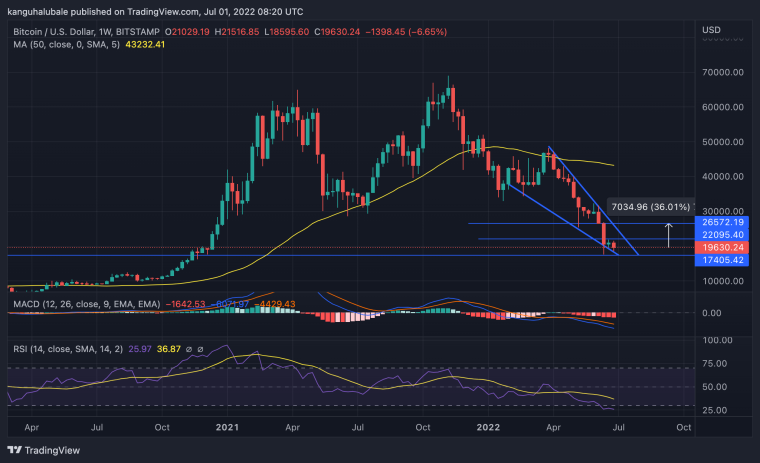
On June 30, Bitcoin (BTC) recorded its worst quarterly loss since 2011 with the price action and activity on the network both plummeting over the last three months.
The second quarter that ended on Thursday saw BTC lose more than half of its value from around $45,000 at the beginning of April to trade at $19,630 at the time of writing this article.
This is the sharpest quarterly price fall since the third quarter of 2011, when the big crypto fell from $15 to $5, a loss of over 66%. It is also worse than the losses witnessed during the 2014 and 2018 bear markets, when Bitcoin’s price plunged 39% and 49% respectively in their worst quarters respectively.
The past three months saw eight consecutive weekly red candles for the flagship cryptocurrency and the month of June alone saw BTC turn town 38%, the worst monthly losses in nearly 11 years.
Bitcoin’s weakness came as the U.S. equities also displayed a dismissal performance. The second quarter of 2022 has been said to be the worst since 1070 for the S&P 500, while the Nasdaq saw its weakest first half (H1) in over 30 years.
A variety of issues have led to the sell-off in both stock and crypto markets. These range from the Ukraine-Russia war to the ongoing impacts of the Covid-19 pandemic. Rising consumer prices and the increase in interest rates by the U.S. Federal Reserve are also factors. The Consumer Price Index (CPI) is currently at its highest level in four decades. Additionally, the depegging of Terra’s UST stablecoin caused the collapse of the Terra ecosystem, while the recent liquidation of one of the largest crypto hedge funds, Three Arrows Capital (3AC), along with the Celsius fiasco, have all contributed to the poor performance seen in the last quarter.
Cryptoassets are a highly volatile unregulated investment product. Your capital is at risk.
Among institutional investors, however, there is fresh evidence that the $20,000 level provided the perfect opportunity to buy Bitcoin. Microstrategy was amongst the brave whales who accumulated more BTC at $20,000. The firm accumulated more of this crypto adding 480 more Bitcoins to its portfolio.
Michael Saylor, the CEO of Microstrategy, announced via a Twitter post that the company’s Bitcoin reserve is now about 129,699 BTC, purchased for around $3.98 billion at an average price of about $30,000. This was also confirmed in the latest 8-K filing with the United States Securities and Exchange Commission (SEC), which indicated that this recent purchase marks a 0.4% increase in their BTC holdings.
MicroStrategy has purchased an additional 480 bitcoins for ~$10.0 million at an average price of ~$20,817 per #bitcoin. As of 6/28/22 @MicroStrategy holds ~129,699 bitcoins acquired for ~$3.98 billion at an average price of ~$30,664 per bitcoin. $MSTRhttps://t.co/leQYTXn817
— Michael Saylor⚡️ (@saylor) June 29, 2022
The business intelligence and software company remains steadfast on its Bitcoin strategy after speculation of a margin call on an over $200 million loan.
Saylor remains optimistically bullish on the bellwether cryptocurrency despite widespread criticism regarding Microstrategy’s latest move. Peter Schif, the Euro Pacific Capital Chief Economist and gold bug, replied to Saylor’s Twitter post, arguing that the move was an attempt to control the market:
“Increasing your stake by less than .004% seems more like an attempt to influence the market by demonstrating your conviction to other investors. But if you’re so sure Bitcoin is cheap, why not buy $100 million? You must think there’s still a lot of downside left in this move.”
MicroStrategy closed down 3.45% Wednesday on the Nasdaq and has dropped over 30% in the past month.
Bitcoin Revisits $19,000 Causing Concerns Amongst Investors
From a technical point of view, Bitcoin price displays concerning signals as bears recently rejected Microstrategy’s attempts to pump the BTC above $20,000. It appears that investors are willing to negotiate the peer-to-peer digital currency at a massively discounted price.
The technical set up displays a falling wedge on the weekly chart (below) which reinforces the belief that BTC price still has a macro uptrend that can only be invalidated by breaching the $12,000 support floor.
The relative strength index corroborates the bullish Bitcoin as the oscillating indicator is currently in the oversold region on the weekly chart. This suggests that the selling pressure on the weekly timeframe could soon run out of steam, paving the way for a trend reversal.
As such, Bitcoin could be lifted off from the current level to confront resistance from the $22,000 mark. If it breaks this barrier, the price may move up to $26,500. Such a move would see Bitcoin price escape from the falling wedge pattern signaling the start of an uptrend.
BTC/Weekly Chart

Alternatively, Bitcoin was trading way below the 50-day SMA which sat at $43,232 and the RSI was still negative, a suggestion that the market was still favoring the downside. In addition, the Moving Average Convergence Divergence (MACD) indicator was moving downward away from the zero line. This was an indication that the market sentiment was bearish.
Therefore, Bitcoin could move below the $17,400 support line to retest the $15,000 psychological level and later the $12,000 support wall.
Related Bitcoin And Analysis News:
- Bitcoin Fights to Hold Onto $20k But $12,500 May Be Coming says FundStrats
- How To Buy Bitcoin With Paypal
- How To Invest In Bitcoin
- Bitcoin Price Prediction 2023 – 2040
- How to Buy Bitcoin ETFs
- How to Earn Free Bitcoin – 12 Ways to Earn Free Bitcoin Instantly
Lucky Block - Undervalued Crypto